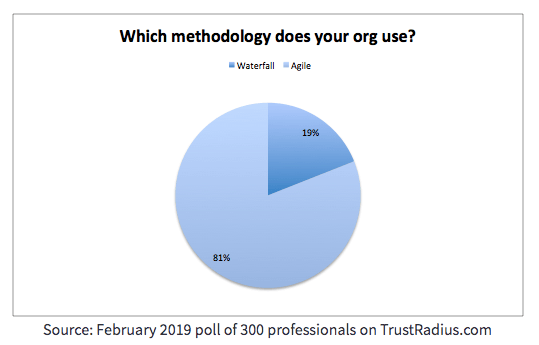5 Project Management Trends To Watch In 2020
10 years ago the project management industry had fewer methodologies, smaller teams and projects, and a ‘one-size-fits-all’ approach to managing projects across organizations.
The discipline has evolved quite a bit since then. Today, there are traditional and agile project management methodologies aplenty, more methodological flexibility, and different software solutions for specific use cases.
Even though the industry has come a long way, there are still new project management trends emerging that will have a tangible impact on the discipline and the project manager role. The trends highlighted below encompass the changes that are being felt in each part of the discipline:
- Artificial Intelligence and Automation for PM Software
- Shifting Makeup of Project Teams
- Mixing Project Management Methodologies
- Multiple Tools for Different Projects
- Importance of Cultivating Emotional Intelligence
1. Artificial Intelligence and Automation for PM Software
Technologies like artificial intelligence, augmented reality, and the Internet of Things (IoT) are driving the fourth industrial revolution and catapulting our society into the digital age. These technologies are impacting industries across the board, and project management is no exception.
AI for project management can help teams automate things such as scheduling tasks, project reporting, and data management and visualization. One example is Microsoft’s Project Cortex, which utilizes AI to create an organization-wide knowledge-base and intelligently categorize information.
AI can also help project managers manage project prioritization and resource allocation across projects. For example, Workfront’s resource management module includes AI-enabled team, project, and resource scheduling. Since AI can help take care of lower-value added tasks, managers will have additional time to focus on more complex and interpersonal tasks, such as relationship-building with clients.
Two benefits you can expect from AI are time savings and productivity gains. Looking to the future, AI will help managers identify where efficiency gaps and project bottlenecks lie and make intelligent recommendations for how teams can increase their productivity.
What does this mean for you?
Does this mean that PM jobs are in jeopardy of being taken over by robots?? Most likely not. If anything, learning how to apply AI to project management will help make your job easier!
You can use AI bots to automate routine and time-consuming tasks like finding the ideal meeting time for your team. AI can also assist with more complex aspects of project management, like gathering productivity insights from reporting or predicting project deadlines.
As a forward-looking PM looking to maximize this technology, it’s your job to figure out which project areas could benefit the most from the application of AI. Find out where your team’s bottlenecks are and identify some simple ways to apply AI and automation to your project planning and execution.
This Todoist reviewer uses AI to help quickly schedule repetitive tasks:
“Todoist gives a great cross-platform to-do list app for us… It’s super flexible and has a great AI for scheduling to-dos. You can simply type ‘take out the trash at 9 a.m. tomorrow’ and it’ll know exactly what you mean. Todoist was the most flexible and feature-rich for the price.”
Danny D. | User Experience Director | Internet Company
2. Shifting Makeup of Project Teams
It’s hard to pinpoint how the trends of companies adopting SaaS solutions en masse and the shift towards more non-traditional work styles are affecting one another.
More and more, project management teams comprise individuals that may be spread out across different locations, work different hours, be a mix of full-time and contract workers, or be from different departments.
Cloud-based collaboration and communication software goes hand-in-hand with the shifting composition of project teams. SaaS applications can help your team stay connected and updated even if they don’t have the same work schedule or work in the same physical office.
How best to adapt
Even though the project management teams of today may look different from the project management teams of yesteryear, the best way to adapt is to embrace this trend and optimize within it. Especially since cloud-based PM tools, the increasing number of remote workers, and the growth of the gig economy are not slowing down, resistance truly would be futile in this case.
For one reviewer, Asana enabled their company to keep remote workers on task, even though they were spread out across 4 different countries:
“We have remote employees in Canada, the United States, India and the Philippines. Due to everyone working in different time zones, communication becomes a problem. By assigning tasks via Asana, everyone knows your schedule for the day and when a task is completed, the next task can start by the next person in line.”
Verified User | Manager in Information Technology | Internet Company
Embracing the shifting makeup of project teams will also help you save costs. Freelancers, or contract workers, reduce labor costs while online communication and collaboration tools can save you travel and administrative costs.
3. Mixing Project Management Methodologies
According to a TrustRadius poll of over 300 professionals, about 80% use an agile project management methodology. However, this doesn’t mean that more traditional approaches (e.g. Waterfall) are going anywhere. Gantt charts and project timelines, both of which are associated with more traditional approaches, are still valuable tools for organizations to use.
In fact, rather than continuing to use discrete and rigid methodologies, many project management teams and offices are now using a blended, or hybrid, approach. These hybrid methods of project management take the best of waterfall, agile, and other project management approaches and combine them.
According to PMI’s Pulse of the Profession (2019) report, 89% of project management professionals surveyed said their organizations use hybrid practices.
Why flexibility is your friend
Why has mixing methodologies become all the rage? One answer is that it better addresses project teams’ need for a flexible workflow. This is in part related to the shifting composition of project teams themselves: a more diverse team means more diverse preferences in project workflow and visualization.
It’s likely that at least a few people on your project team might be remote workers, or be from different departments. Providing each individual with the flexibility to use the project management method that works best for them while still being able to manage overall project progress is an essential skill for a project manager to have.
Luckily, there are plenty of PM tools available that can help you make this happen. Products like Airtable, Asana, monday.com, Workfront, and Wrike all allow individual users to visualize project tasks in multiple different ways. These include timeline views, Kanban boards, Gantt charts, task lists, etc).
For example, this reviewer loves Airtable because of the flexibility it affords their team:
“Airtable is excellent for collaboratively submitting, sharing, and manipulating data and information. It is quick to set up different databases, and offers a multitude of templates and views to help make things as productive as possible. It also offers task sharing and management with its kanban view.”
Verified User | C-Level Executive in Corporate | Computer Software Company
Checking out free trials or free versions of these different products is a great way to get a feel for which one would work best for your team.
4. Multiple Tools for Different Projects
Project management tools help teams manage all their tasks and daily to-dos, streamline communication, and stay organized. However, certain tools are better suited for specific types of projects. For example, Trello is ideal for task management, while Jira is a popular bug and issue tracking project management software.
One result of this is that project management professionals are more likely to use multiple project management tools instead of just one.
How to keep up with your team
As long as your budget allows, you may find that using multiple PM tools is truly the most efficient way to organize your projects. Just be sure to remain aware of red flags that indicate you may need a more centralized solution. For instance, if you start noticing project details getting lost in the transition between tools, or if your team members complain of missed hand-offs, you’ll know it’s time to make the hard move toward simplification.
Most companies will find that 2 project management tools will suffice for their needs. For example, this reviewer uses both Trello and Asana depending on the situation at hand:
“Both Trello and Asana are great. I’m happy to use either of them, depending on what the situation requires. In our case, the web developers were already using Trello, so that’s what we use to collaborate with them. But for our internal tasks, I use Asana, as it seems a little more polished.”
Verified User | Executive in Information Technology | Religious Institutions Company
5. Importance of Cultivating Emotional Intelligence
Technology is playing an ever-larger role in helping streamline project management operations. But that doesn’t mean that the ‘people’ part of project management is fading into the background.
With AI and automation taking over more routine PM tasks, project managers have more time to focus on serving the interpersonal, emotional, and motivational needs of their team. This means that today’s project managers are prioritizing the development of soft skills, including:
- ability to motivate and energize their team
- ability to empathize with team members
- organizational and coordination skills
- ability to negotiate with internal and external stakeholders
- strong communication skills
Why you should invest in developing ‘soft skills’
Taking the time to invest in developing your set of ‘soft skills’ and boosting your emotional intelligence can help you become a more valuable (and marketable) project manager.
Miscommunication and misaligned interests/goals soak up both time and money. Achieving a better understanding of the different personalities on your project team and what each one of them needs will help make you a better project manager and cut down on wasted resources.
You might be wondering how to go about developing and honing these skills. One good resource to use is your organization’s professional development fund.
Many companies have a professional development budget that you can use to enhance existing skills or develop new ones. Leadership courses, project management workshops, and any other courses that focus on learning how to work collaboratively (and successfully) as a group are a great place to start.
There have also been hundreds of books written about how to be a better leader. Here’s one list of the 10 best books for leaders that want to increase their emotional intelligence to help get you started.
Exciting or Overrated—A few 2020 predictions
The thing about trends is that they’re just that—trends. There’s no guarantee that any of the changes above will fully take root in the project management industry. However, based on the way things are headed, it’s possible to make a few predictions about which trends are likely here to stay and which ones might be bunk.
The movement towards cloud technology, the rise of the gig economy, and the growth of remote working culture are unlikely to be disrupted by any one industry alone.
However, one trend that may be reversed in the next 10 years is individuals using multiple tools rather than one. If we see more consolidation in the project management software market, solutions that have the capabilities required for all types of project management methodologies and use cases may emerge.
It’s possible that project management tools may become even more specialized over the next 5-10 years. If this happens, each type of PM tool would likely carve out a small chunk of the market, resulting in a fragmented market landscape broken up by use case.
That’s as far as I can see into the crystal ball for now, but what are your project management predictions for 2020 (and beyond)?
Was this helpful?

